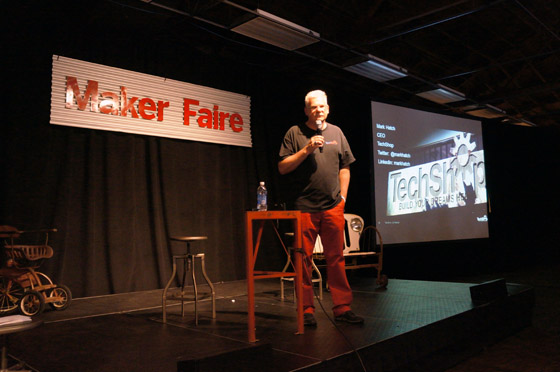How the 'creative class' is re-making the world


Our largest untapped resource for innovation and a growing economy is not solar or wind power. It's not social networking or electric vehicles. It is the many millions of people who have the free time, disposable income, knowledge and passion required to make things.
Or at least, that's what Tech Shop CEO Mark Hatch explained to a packed house of computer hobbyists, DIY fans and makers of all stripes at the seventh annual Maker Faire in San Mateo, Calif., on Saturday, May 19.
Tech Shop is often called a health club for makers, geeks and tinkerers. The shops -- there are five locations now (including a new one near Detroit) with more on the way -- are membership-based workshops filled with otherwise inaccessible and often hugely expensive machinery, such as CNC mills, 3D printers and laser cutters.
Tech Shop memberships start at $100/month (which Hatch likened to "the cost of a bad coffee habit") and the garages make manufacturing "cheap, easy, powerful and accessible for the first time in 200 years," he said.
Through its ideas, experiments and inventions, the creative class is stoking what The Economist calls the third industrial revolution. It is populated by people whose skills in computed-aided design and access to new materials is changing the world of manufacturing (more on that in my next post from Maker Faire).
Hatch rattled off a long list of startups that used Tech Shop to build their earliest prototypes and form connections with like-minded members of the creative class. "We've launched hundreds of companies in the past five years," he said.
Some of the examples he offered:
- Patrick Buckley used Tech Shop to cheaply prototype his Dodocase for the iPad -- a product that netted $1 million in sales within five months.
- Naganad Murty met a polymer industry veteran at Tech Shop, who helped him design the Embrace baby wrap, a product for the developing world that is designed to help keep premature babies alive until they can be brought to a hospital.
- Phil Hughes used Tech Shop as he developed a low-energy system for keeping server farms cool -- a system that went on to beat out IBM in a Department of Energy competition that earned Hughes a $2.8 million grant to grow his company.
The Maker Movement and Tech Shop
Tech Shop was the brain child of Jim Newton, a particularly inventive and ambitious tinkerer, who helped foster this creative class by giving them a space to prototype their ideas. But Tech Shop, Maker Faire and Make magazine, its creator, are all part of a growing industry that services this creative class (and, one could argue, also created it).
Two factors have led to the rise of the creative class: money and increasingly accessible manufacturing equipment.
"The creative class has hundreds of millions of dollars of disposable income," Hatch said.
Increasingly, that money is landing in Tech Shop's accounts. It's not just that membership and Tech Shop locations are growing, it's that the cost of the manufacturing equipment they offer is falling. Machines that used to cost more than $100,000 can now be had for around $5,000. And the knowledge base needed to use the computer aided design tools needed to move from the idea to prototype stage is also spreading, thanks largely to open source software and hardware/software platforms such as Arduino.
But, the larger the movement grows, the more accessible -- and mainstream -- these tools are becoming. Already, 3D printers are becoming affordable. Inventables was selling the desktop 3D printers at the Faire for just under $200. So if interest in making things continues to grow (and I'm not sure it will) while the tools needed to do small scale, rapid manufacturing become ever more affordable, what will this movement look like in five, 10 and 15 years? Will Tech Shop suffer or benefit? More importantly, will the creative class continue to spark new ideas and companies?
Perhaps, as has been suggested, the greatest opportunity for small scale manufacturing is in the developing world. But can Tech Shop be replicated in regions that aren't flush with people who have sizable disposable incomes?
I'd love to hear your thoughts.
Related:
- The creative class is alive (by Richard Florida, who coined the term creative class)
Image: Mary Catherine O'Connor
This post was originally published on Smartplanet.com